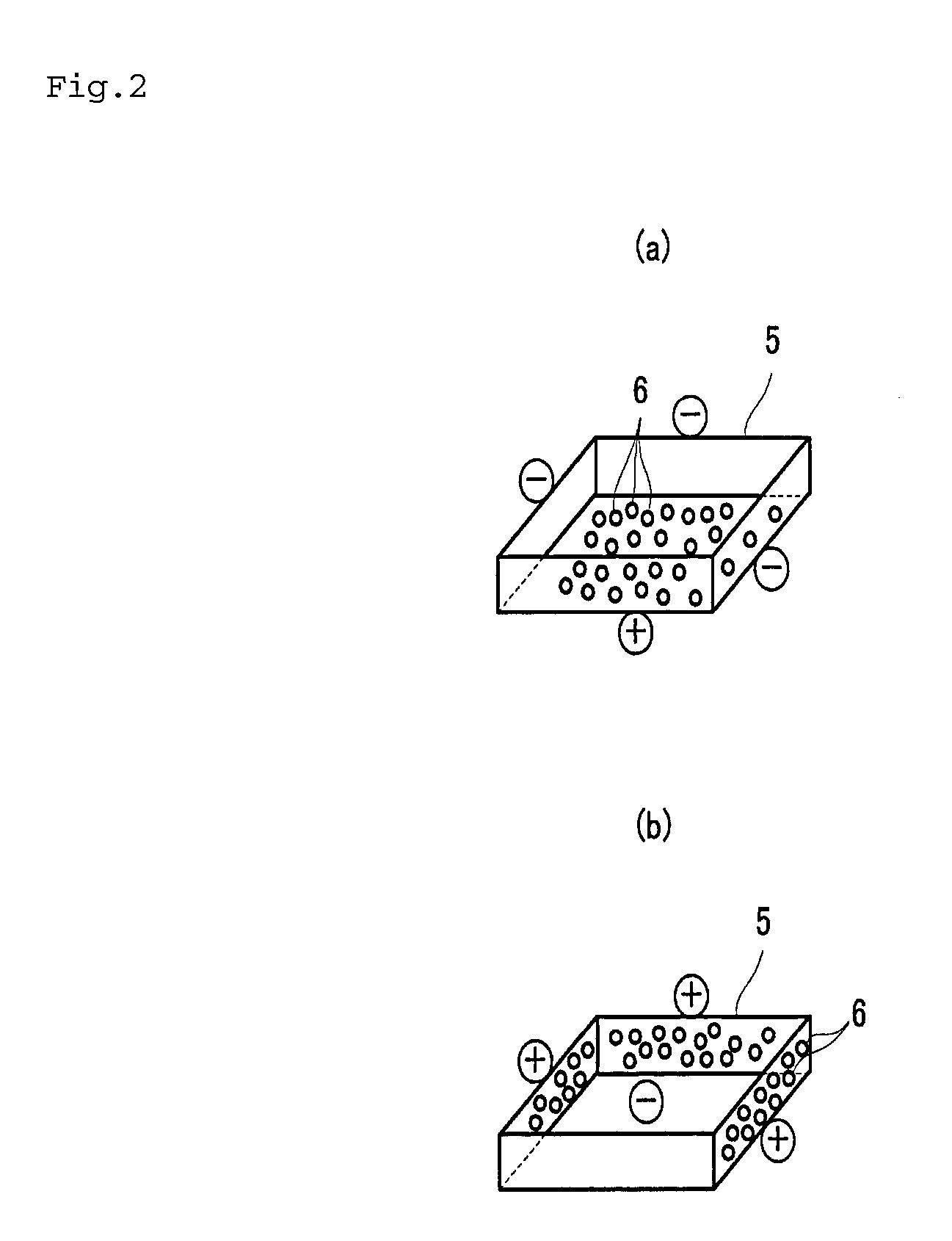Fine electretic particles and process for producing same
- Summary
- Abstract
- Description
- Claims
- Application Information
AI Technical Summary
Benefits of technology
Problems solved by technology
Method used
Image
Examples
Example
Examples 1 to 5 and Comparative Examples 1 to 5
[0133]The following were used as starting materials for producing fine electret particles. Table 1 shows the specific formulation.[0134]A. VT470 (fluorine-containing resin: shell-part material)[0135]B. Dispersibility-improving resin (i.e., polymeric dispersant, three types shown in Table 1)[0136]C. Urethane resin beads[0137]D. Acrylic resin beads[0138]E. PVA224 (starting material for an emulsifier)
[0139]Fine electret particles were prepared according to the following procedure.
[0140]A fluororesin (VT470) was dissolved in ethyl acetate to a concentration of 5%, and a dispersibility-improving resin was dissolved in the ethyl acetate to a concentration of 2%. Resin beads C and D were individually mixed with the respective solutions with stirring.
[0141]PVA224 was dissolved in ion-exchange water to a concentration of 5% to obtain an emulsifier. The resin-bead-mixed dispersion was weighed (200 g) and stirred at 2,000 rpm using a homomixer. T...
Example
Test Example 1 (Electrophoresis Test)
[0143]An electrophoresis test was conducted on the fine electret particles obtained in Examples 1 to 5 and Comparative Examples 1 to 3 using the electrophoresis test device shown in FIG. 4. Specifically, the test was conducted as follows.
[0144]An ITO-coated glass sheet produced by Kuramoto Co., Ltd. (300 mm (height)×400 mm (width)×0.7 mm. (thickness), 7 Ω / sq or less) was cut into 30 mm×50 mm pieces. Sumitomo 3M double-sided adhesive tape (Scotch super-strength double-sided adhesive tape, 19 mm (width)×4 m (length)×1 mm (thickness)) was cut into 20-mm pieces, and an 8-mm-diameter hole was made in the central portion of the pieces.
[0145]The 20-mm adhesive tape was attached somewhat left of the center of the ITO-coated glass surface.
[0146]The hole in the double-sided adhesive tape was filled with the fine electret particles in an amount without overflow
[0147]The liner was peeled off from the other side of the double-sided adhesive tape, i.e., the si...
Example
Test Example 2 (Dispersibility Test)
[0151]A dispersibility test was conducted on the fine electret particles obtained in Examples 1 to 5 and Comparative Examples 1 to 3. Specifically, the test was conducted as follows.
[0152]KF96-1CS silicone oil (Shin-Etsu Chemical Co., Ltd) and Isopar G (ExxonMobil Chemical) were provided for use as an electrophoretic medium. The fine electret particles of the Examples were individually added to the respective electrophoretic media, and the mixtures were fully stirred with a spatula to obtain dispersions.
[0153]Subsequently, a drop of each of the dispersion liquids was sucked up with a dropper and individually placed on a microscopic glass slide. A cover glass was placed over each of the glass slides, and samples for observation were thereby prepared.
[0154]The samples were observed under magnification using an optical microscope to evaluate the dispersibility of the fine particles.
[0155]Table 1 shows the evaluation results of the dispersibility of t...
PUM
| Property | Measurement | Unit |
|---|---|---|
| Length | aaaaa | aaaaa |
| Length | aaaaa | aaaaa |
| Fraction | aaaaa | aaaaa |
Abstract
Description
Claims
Application Information
 Login to View More
Login to View More - R&D
- Intellectual Property
- Life Sciences
- Materials
- Tech Scout
- Unparalleled Data Quality
- Higher Quality Content
- 60% Fewer Hallucinations
Browse by: Latest US Patents, China's latest patents, Technical Efficacy Thesaurus, Application Domain, Technology Topic, Popular Technical Reports.
© 2025 PatSnap. All rights reserved.Legal|Privacy policy|Modern Slavery Act Transparency Statement|Sitemap|About US| Contact US: help@patsnap.com



